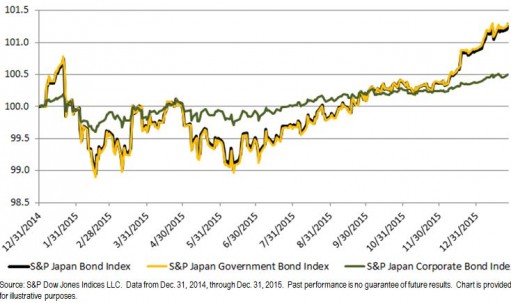Question One: How big is Japan’s local currency bond market? How does it compare to China’s bond market?
The size of the local currency bond market in Japan (tracked by the S&P Japan Bond Index) stood at JPY 1,154 trillion as of Jan. 27, 2016, which is equivalent to USD 9.7 trillion. It is 1.7 times the size of the local currency bond market in China, as measured by the S&P China Bond Index. Japanese sovereign bonds represent over 70% of market exposure; the current yield-to-maturity of the S&P Japan Sovereign Bond Index is 0.22%, compared with 2.83% for the S&P China Sovereign Bond Index.
Question Two: How did bonds perform in 2015?
The S&P Japan Bond Index gained 0.87% in 2015, benefiting from a rally in the last quarter (see Exhibit 1). The index’s yield-to-maturity tightened by 15 bps to 0.24% in the same period. In government bonds, the S&P Japan Sovereign Bond Index outperformed and increased 1.04%. Within the corporate sectors, the S&P Japan Utilities Bond Index was up 0.95%, beating other sectors like financials, services, and industries.
Question Three: What about inflation-linked bonds?
Riding on weakening inflation expectations, the S&P Japan Sovereign Inflation-Linked Bond Index dropped 0.63% for the year. The index’s yield-to-maturity has remained in negative territory since the second half of 2015 and stood at -1.15% as of Jan. 27, 2016.
The Bank of Japan (BoJ) announced on Jan 29 that it will apply a rate of negative 0.1% to excess reserves that financial institutional place at the bank, with the goal to push down borrowing costs to stimulate inflation. The BoJ aims to meet its 2% inflation target; reaching that target has been delayed due to weak consumer spending and the deflationary impact of the drop in oil prices.
Exhibit 1: Total Return Performance of the S&P Japan Bond Index
The posts on this blog are opinions, not advice. Please read our Disclaimers.














































 Source: S&P Dow Jones Indices LLC. Data as of Jan. 22, 2016. Past performance is no guarantee of future results. Table is provided for illustrative purposes.
Source: S&P Dow Jones Indices LLC. Data as of Jan. 22, 2016. Past performance is no guarantee of future results. Table is provided for illustrative purposes.

